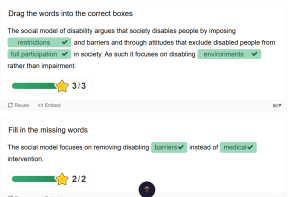5
Section one: The fundamentals
A)
Exercise 1: Notebook Prompt
Many of you are likely familiar with the concept of “ability inequity,” which the authors of this article define as “an unjust or unfair (a) ‘distribution of access to and protection from abilities generated through human interventions’ or (b) ‘judgment of abilities intrinsic to biological structures such as the human body’.”
However, they go on to identify the following “ability concepts” that are less familiar:
1) ability security (one is able to live a decent life with whatever set of abilities one has)
2) ability identity security (to be able to be at ease with ones abilities)
How prevalent are these forms of security among disabled people you know? Or, if you identify as a disabled person, would you say your social surroundings and community foster and support these kinds of security? Furthermore, while the focus of the article is on Kinesiology programs, it is also important to reflect on how academia in general accommodates for disability. If you feel comfortable answering this question, what has been your experience of postsecondary education to date?
-OR-
The authors also observe that “Ableism not only intersects with other forms of oppression, such as racism, sexism, ageism, and classism, but abilities are often used to justify such negative ‘isms’.”
What do you think this means? Provide an example.
| To me, this means that ableism is used as an excuse for undercover racism, sexism, ageism and classism. In sports, this could mean that someone is excluded from a team because of a perceived ability, but also perhaps because of their age. Abilities like physical strength, cognitive skills, or communication abilities can be used to justify these forms of oppression.
|
Exercise 2: Implicit Bias Test
Did anything surprise you about the results of the test? Please share if you’re comfortable OR comment on the usefulness of these kinds of tests more generally.
| My score was not as neutral as I had expected. I scored in the moderate automatic preference stage, which was really surprising as I don’t think that is how I actually feel or behave in my life. I also think there was a kind of meta part; I was thinking about how the test would be altered by my behaviour, taking out some of the reliability of the test.
|
B) Keywords
Exercise 3:
Add the keyword you contributed to padlet and briefly (50 words max) explain its importance to you.
|
|
B) On Disability
Exercise 4: Complete the Activities


Exercise 5: Notebook Prompt
What do Fitzgerald and Long identify as barriers to inclusion and how might these apply to sport in particular?
- Physical Barriers: Inaccessible facilities or equipment that prevent participation.
- Social Barriers: Negative attitudes, stereotypes, or social exclusion.
- Cultural Barriers: Lack of representation or culturally relevant programs.
- Organizational Barriers: Inflexible policies, limited funding, or inadequate support systems.
In sport, a lack of accessible sports venues may prevent disabled athletes from participating. Organizational barriers, such as limited adaptive equipment or exclusionary rules, can further restrict opportunities for disabled individuals in sports.
C) Inclusion, Integration, Separation
Exercise 6: Complete the Activities

Exercise 7: Notebook Prompt
Choose ONE of the three questions Fitzgerald and Long argue disability sport needs to address and record your thoughts in your Notebook.
- Should sport be grouped by ability or disability?
- Is sport for participation or competition?
- Should sport competitions be integrated?
| In my opinion, sports should be for participation instead of competition. Although, I need to admit, I typically play sports for participation instead of competition, which biases my opinion. Making sports less about competition allows people to play for fun and exercise without having to exclude anyone or prevent anyone from playing. Teams could be built to be accessible to everyone. However, sports are more typically played for competition. With the prevalence of championships, awards, sports based scholarships, etc, it makes sense that our society most values competition.
|
Part Two: Making Connections
A) Gender, Sport and Disability
Exercise 8: Complete the Activity
The paradox that sportswomen habitually face (as the authors observe, this isn’t confined to disabled sportswomen) involves the expectation they will be successful in a ‘masculine’ environment while complying with femininity norms in order to be recognized as a woman.
True or false?
Take a moment to reflect on this paradox below (optional).
| This is true. Often, clips of sportswomen that go viral are when they are dressed as traditionally feminine as possible, or when they are the only ones wearing a dress on a panel of men wearing jerseys. |
B) Masculinity, Disability, and Murderball
Exercise 9: Notebook/Padlet Prompt
Watch the film, Murderball and respond to the question in the padlet below (you will have an opportunity to return to the film at the end of this module).
The authors of “Cripping Sport and Physical Activity: An Intersectional Approach to Gender and Disability” observe that the “gendered performance of the wheelchair rugby players can…be interpreted as a form of resistance to marginalized masculinity” (332) but also point out that it may reinforce “ableist norms of masculinity.” After viewing the film, which argument do you agree with?
a) Murderball celebrates a kind of resistance to marginalized masculinity
| In my opinion, murderball reinforces ableist norms of masculinity. Instead of trying to rewrite ideas of traditional masculinity, murderball encourages dominant ideas of men in society, without providing an alternative perspective. The male athletes in the film appear to overcompensate for their disability by adopting some of the most aggressive and intense traits, both on and off the court.
This performance of exaggerated masculinity encourages athletes displaying hypersexual, emotionally detached, and combative behaviours to assert their dominance. Rather than dismantling gendered expectations, the film positions these traits as a necessary means for disabled men to reclaim legitimacy and power. In doing so, it sidelines more nuanced or vulnerable expressions of masculinity, reinforcing the idea that strength and aggression are the only valid ways to navigate life with a disability.
|
Section Three: Taking a Shot
A) Resistance
B) Calling out Supercrip
Exercise 10: Mini Assignment (worth 5% in addition to the module grade)
1) Do you agree with the critique of the “supercrip” narrative in this video? Why or why not? Find an example of the “supercrip” Paralympian in the 2024 Paris Paralympics or Special Olympics coverage and explain how it works.
|
|
2) Does the film Murderball play into the supercrip narrative in your opinion? How does gender inform supercrip (read this blog for some ideas)?
(300 words for each response)
|
|

